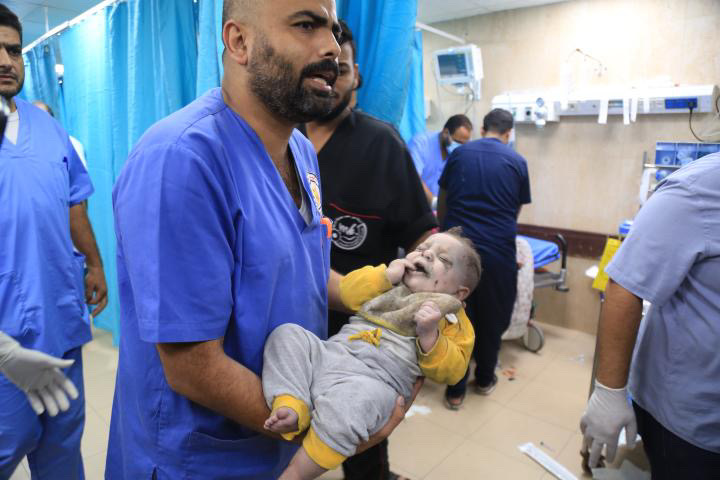Warning: This story contains graphic images. All photos and videos by Fadel Mghari.
Journalists and photographers in Gaza have captured horrific scenes of destruction in the weeks since Israel declared war against Hamas its response to the Oct. 7 terror attack.
After the massacre, in which Hamas killed some 1,400 Israelis and took 200 more as hostages, Israel launched an aggressive effort to destroy the group. The siege of Gaza has come in the form of airstrikes that have leveled buildings and killed thousands of Palestinians so far, according to local officials.
Gaza-based journalist Fadel Mghari shared with Mediaite horrific images showing what he’s seen in the densely-populated enclave. The photos and videos, which are extremely graphic, are from the al-Aqsa Hospital, which like other hospitals in Gaza has been overrun.
In one image, three babies who appear to be dead are lined up next to each other. Medics desperately work to salvage any hope of life.
In a video taken by Mghari, six lifeless children are laid across the hospital floor on a white sheet covered in blood. To the far right there is an infant wearing only a diaper covered in ash, beside another child whose upper body is burned so badly they were only distinguishable from the legs down.
The images were taken after an Israeli airstrike in Deir al-Balah, a city in central Gaza, Mghari said.
The photojournalist has faced his own share of tragedy since the war started. He told Mediaite he lost members of his own family in an airstrike at the Bureij refugee camp.
“Fifty-four family members were lost and killed in an airstrike on the Bureij camp,” he said. “My aunt, her children, and the children of my family were all killed. Why? What crime did they commit?”
“Fifty-four people from a family were killed and we cannot bury them,” Mghari said.
Mghari spoke to Mediaite over a course of several days. He was only able to communicate in short stints due to a continuous loss of electricity and internet.
“My heart is not used to bearing what is happening here,” he said Tuesday. “Real massacres against children. Today, after seven days, we began arriving at the bodies of my relatives. We found nothing but body parts. We do not know which of them — it’s just a pile of body parts. I think that for a moment I do not comprehend the scene.”
“We want a period of calm so that we can cry for those we lost,” he said. “Oh God. Please tell the world. I don’t know how long they will keep the bombing going on around us.”
While the United States has promised humanitarian aid to Palestinians in Gaza, Mghari told Mediaite what has come in so far is hardly enough to stave off a humanitarian disaster.
“The aid that has arrived is very small, and I do not think it is enough for a quarter of an area,” he said.
“The electricity has been cut off for 14 days and we live in complete darkness, and there is no water in the networks because most of them have been bombed,” Mghari said. “We use some of the few water networks to cover a very small part of our needs.”
He said his community has tried to stretch their scarce resources by scheduling times to eat and drink.
“We organize the times for drinking water and food so that we can [have] it the next day,” he explained.
Amidst the devastation, Mghari has sought to capture what he can on his camera: desperate doctors trying to save children’s lives after missile attacks; mothers mourning their children wrapped in white sheets serving as body bags; the destruction of the city he calls home.
“We can no longer bear it,” Mghari said Tuesday. “Tell the world, the dead are children and women. There is nothing left. They destroyed everything, no trees, no stones, nothing, nothing. We are waiting for our turn to die.”





